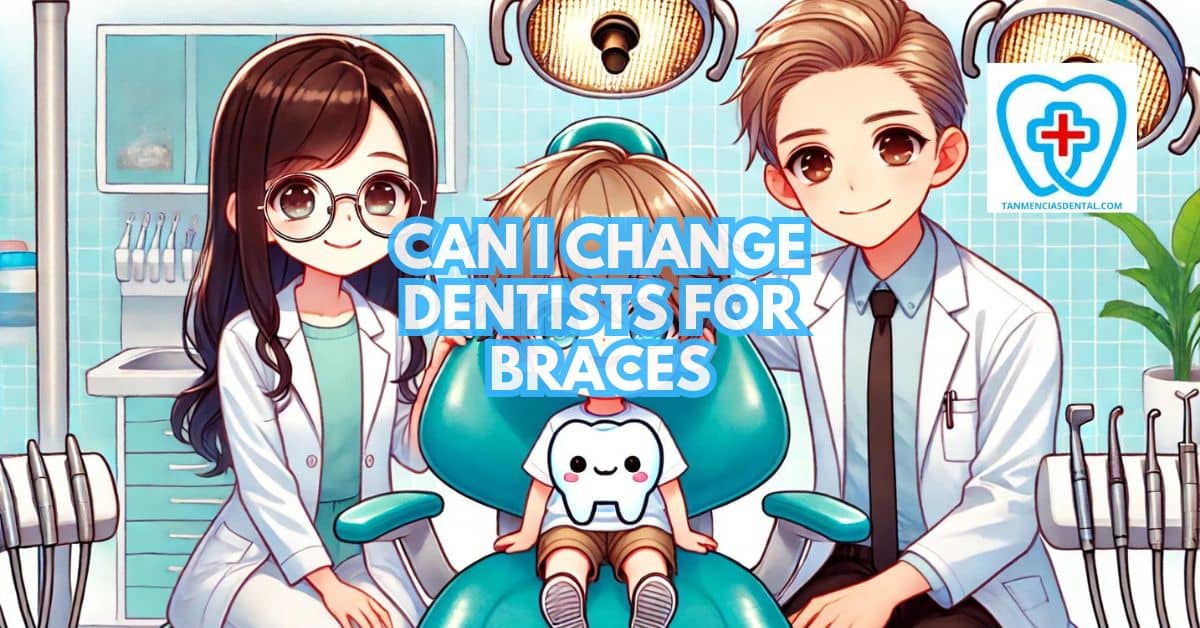Starting orthodontic treatment with braces is a significant commitment that requires ongoing care and attention.
However, situations may arise where you find yourself asking, “Can I change dentists for braces?”
This question often comes up due to factors like relocating to a new area, financial concerns, or feeling unsatisfied with your current orthodontic care.
Changing orthodontists in the middle of treatment can be a challenging process, as it involves careful coordination to ensure your treatment plan is continued effectively.
It’s important to understand the steps involved in this transition to protect the progress you’ve made and to avoid any potential setbacks in your orthodontic journey.
1. Understanding Reasons for Changing Orthodontists During Braces
When undergoing orthodontic treatment, such as braces, patients may face situations that lead them to consider changing their orthodontist.
One of the key questions that arises is, “Can another dentist adjust my braces?”
The answer largely depends on the complexity of the treatment and the willingness of another orthodontist to take over your care.
Common motivations for seeking a new orthodontic care provider include relocating to a new area, making it challenging to continue visits with the current provider.
Sometimes dissatisfaction due to the level of care, poor communication, or not seeing the expected progress can also prompt patients to look for change.
Financial considerations, such as changes in insurance coverage or the need for more affordable options, can further necessitate the search for a new orthodontist within the network.
To ensure a smooth transition, obtaining a transfer form from your current orthodontist detailing your treatment progress is a critical step in moving forward with a new provider, making the decision to switch an informed and well-considered one.
🦷 Choosing the Best Toothbrush for Your Teeth
2. Assessing Feasibility: Transitioning to a New Orthodontist
Before making any decisions, it’s important to evaluate the feasibility of transitioning to a new orthodontist.
This includes considering whether potential new orthodontists are willing to take on your case mid-treatment, which is not always a guarantee.
Factors such as compatibility with the new orthodontist’s treatment methods, availability, and willingness to align with your treatment goals are vital.
You must also consider the logistical aspects, such as the proximity of the new orthodontist to your home or work.
An initial consultation is essential to discuss your current treatment status and assess whether the new orthodontist can meet your expectations and continue your care effectively.
🦷 Are Dentists Frontline Workers?
3. The Transfer Process: Steps to Change Orthodontists Mid-Treatment
Switching orthodontists during braces is a decision that involves a few crucial steps to ensure the continuity and success of your orthodontic treatment.
The process begins with an open and honest discussion with your current orthodontist about your reasons for wanting to change.
This conversation is vital, as it sets the stage for a cooperative transition.
Following this, it’s essential to secure your dental records, including your treatment plans and progress reports.
These documents are indispensable for your new orthodontist to understand where you are in your treatment journey.
Identifying and consulting with potential new orthodontists allows you to assess who is the best fit to continue your care, ensuring they have a clear understanding of the orthodontics required for your specific case.
After selecting a new orthodontist, a formal transfer request is made to hand over your dental records from your previous orthodontist, facilitating a seamless continuation of your treatment.
This step is crucial as it ensures both your previous and new orthodontists can communicate effectively, covering all details of your treatment thus far for a smooth transition.
🦷 Brushing Methods: Pros and Cons
4. The Role of Clear Communication in Changing Orthodontists
Clear communication plays a vital role in successfully transitioning from one orthodontist to another.
When you clearly express your treatment history, current progress, and any concerns, both your old and new orthodontists can collaborate effectively.
This exchange of information helps to avoid any gaps in your care, ensuring that your treatment continues seamlessly.
Additionally, it allows your new orthodontist to tailor their approach to your specific needs, minimizing the risk of complications.
Overall, transparent communication is key to maintaining the quality and consistency of your orthodontic treatment during the change.
🦷 How to Build a Brushing Routine
5. Choosing Your New Orthodontist: Finding the Right Fit
Selecting a new orthodontist is a crucial step that requires careful consideration.
You should look for a professional who not only has a solid reputation and extensive experience in treating cases similar to yours but is also someone you feel comfortable communicating with.
Consider scheduling initial consultations with several orthodontists to discuss your ongoing treatment and gauge their approach to your care.
Recommendations from friends, family, or even online reviews can provide valuable insights into the orthodontist’s practice and patient satisfaction.
Your decision should be based on a combination of professional expertise and a personal connection, ensuring they understand your treatment goals and can provide the care you need.
🦷 Guide to Choosing a Toothbrush for Gingivitis
6. Financial Considerations Amid Orthodontic Treatment
Changing orthodontist mid-treatment can have significant financial implications.
You may encounter additional costs for the transfer, initial assessments, and potentially different treatment plans that the new orthodontist might propose.
Discussing financial matters transparently with both your current and prospective orthodontists can help you understand your financial responsibilities and avoid unexpected expenses.
Some orthodontists offer flexible payment plans or financing options, so it’s worth inquiring about these.
Additionally, verify your insurance coverage, as some plans may cover a portion of the costs associated with changing orthodontists, including new patient consultations and record transfers.
7. Handling the Transfer of Dental Records
The successful transfer of your dental records is pivotal for continuity of care.
Your records, including X-rays, photographs, and detailed notes on your treatment progress, provide the new orthodontist with a comprehensive view of your orthodontic history.
Ensure that you obtain a copy of your records from your current orthodontist, or verify that they can be directly transferred to your new orthodontist’s office.
It’s important to check that all documentation, especially detailed treatment plans and any changes made during your care, are included.
This step ensures that your new orthodontist has all the necessary information to continue your treatment effectively and without unnecessary delays.
🦷 How Often to Brush with Baking Soda
8. Adjusting to a New Treatment Plan
Transitioning to a new orthodontist may require adjustments to your current treatment plan.
After evaluating your dental records and treatment history, the new orthodontist might suggest modifications to achieve the best possible outcome.
While changes can be unsettling, they often reflect the new orthodontist’s expertise and commitment to optimizing your treatment.
Openly discuss any proposed changes, understanding the rationale behind them and how they might affect your treatment timeline and results.
It’s crucial to maintain an open line of communication, expressing your concerns and preferences, to ensure the new treatment plan aligns with your expectations and goals.
🦷 Budgeting for Dental Checkups and Cleanings
9. Impact on Treatment Duration When Changing Orthodontists
Changing orthodontists mid-treatment can have an impact on the overall duration of your orthodontic care.
The new orthodontist may have different treatment philosophies or techniques that necessitate adjustments to your existing treatment plan.
These modifications, while aimed at improving outcomes, may extend the time required to complete your treatment.
It’s important to have realistic expectations and understand that achieving the best possible result may take longer than initially anticipated.
Having a detailed discussion about potential changes in treatment duration with your new orthodontist will help set clear expectations for the journey ahead.
🦷 Why Is Dental Work Expensive?
10. Emotional and Psychological Considerations
The decision to change orthodontists and the transition itself can be emotionally taxing.
Feelings of uncertainty and anxiety about the new orthodontist and the potential changes to your treatment plan are common.
It’s crucial to acknowledge these feelings and consider the emotional and psychological impact of transitioning to a new care provider.
Building a trusting relationship with your new orthodontist and their team can help alleviate concerns and make the transition smoother.
Remember, the goal of any change should be to enhance your comfort and satisfaction with your orthodontic care.
🦷 Are Dentists Rich? The Real Story
11. Legal and Ethical Aspects of Orthodontic Transfer
Navigating the legal and ethical considerations involved in transferring orthodontic care is an essential part of the process.
Both your current and new orthodontists must handle your case with professionalism, respecting confidentiality and patient rights throughout the transfer.
It’s important to ensure that consent forms and privacy agreements are properly managed and that all parties adhere to the highest standards of patient care and ethics.
Understanding your rights as a patient and ensuring that they are respected is a critical component of a successful orthodontic transfer.
🦷 Can Baking Soda Remove Tartar?
👨⚕️ Conclusion
Deciding to change orthodontists in the middle of your treatment is a critical choice that requires thoughtful planning.
You must carefully evaluate the reasons behind your decision, such as dissatisfaction with your current care or logistical challenges like relocation.
Additionally, consider the financial costs, as switching providers may involve transfer fees or changes in insurance coverage, as well as the emotional stress of adapting to a new orthodontist.
It’s essential to have clear and honest discussions with both your current and potential new orthodontist to ensure that your treatment plan will continue smoothly.
Your primary aim is to maintain the progress of your treatment while ensuring that you are supported by a care team that understands and meets your needs.
😁 Self-Promotion
Discover the path to a brighter smile at Tan-Mencias Dental Clinic, nestled in the heart of Parang, Marikina City!
Our friendly and professional team is dedicated to providing exceptional dental care in a comfortable and welcoming environment.
For any questions, concerns, or to schedule your next visit, feel free to call us at 9171451074, drop us a message on our Facebook page, or use the contact form on our website.
We’re here to make your dental experience as smooth and pleasant as possible.
Let us be a part of your journey to a healthier, happier smile!

